
Hands up. Who likes to worry about things like unexpected bills and emergency expenses? We’re not surprised the answer isn’t exactly affirmative. Indeed, an unanticipated, expensive problem can throw your entire world out of whack. And no one wants that, right?
Unfortunately, not many of us are lucky enough to have the money left over at the end of each month to build a rainy day savings account quickly. By the time you’ve finished spending on your mortgage or rent, your bills, and a little fun, too, most find that there’s nothing left for saving.
Perhaps it’s time to reassess your approach to your finances and make a change. Here’s how; our 5 lifestyle changes and savings tips that might just change your life.
GET REAL
First things first, if you want to make a real difference to your cash situation, you need to be real with yourself. Real honest. Real, real frank with the situation. Take a really long look in the mirror. That’s enough, but you get the picture.
That means giving your outgoings an audit and seeing if there’s anywhere you could make adjustments or any seemingly frivolous spending which could, for now, be trimmed.
Gather all your bank statements and spending information and make a list of your necessary and unnecessary expenses. From there, you’ll be able to see where your biggest problem areas are so you can start to make changes.

GOALS & TARGETS
Having a clear plan in place for saving, with goals to reach and targets you wish to buy, can make things more manageable. Structure and reason works here, make no mistake. So, instead of simply sticking a fiver in your piggy bank every so often and hoping for the best, try to devise a saving plan which you can stick to.
That could be as simple as putting 10% of your wages each month, to investing a little money now with the hope it’ll gain you more later down the line.
MAKE SAVING SIMPLER
Budgeting can sometimes be a challenge, but saving doesn’t have to be tough. Once you’ve spent the time looking at your budget and figuring out how much you can afford to put away at the end of each month, you can make your saving strategy a little simpler.
You can do this by setting up automatic payments from your current account to your savings account. By doing this, you don’t even have to think about the transaction; it all occurs behind the scenes.
Most bank accounts will allow you to do this, and the quicker you get the money from your pay into your savings account, the less likely you are to spend it. Automating your savings means that by the time you look at your bank account after being paid each month, you’ll know how much you can afford to spend without ignoring your savings.

START SMALL LAND THINK BIG
You don’t need to make a million changes to your lifestyle overnight to be a good saver. All you really need is to make small changes with a big goal in mind. You could start by cutting out that one last pint at the pub, when you don’t need it anyway, and incrementally increase those sacrifices.
You can also try targeting problem areas with your spending one at a time too. Focusing on things like problems with eating out too often before you start looking at issues with over-spending on tech means that you won’t be trying to make too many major changes in your life at once. Rushing into changes too fast isn’t sustainable. Slow and steady wins the race, hey?
UNSUBSCRIBE
Finally, if you’re prone to falling victim to temptation every time you get an email or text message from a brand you like, unsubscribe from them. Don’t follow them on social media, and make sure that you remove yourself from their mailing list. Out of sight, out of mind, as they say.
If you don’t want to unsubscribe, make sure that you at least implement a 24-hour rule on any purchase that you’re tempted to make based on a marketing message. Allow the idea of purchase percolate for a day, return to it, and then deem if it really is necessary.




